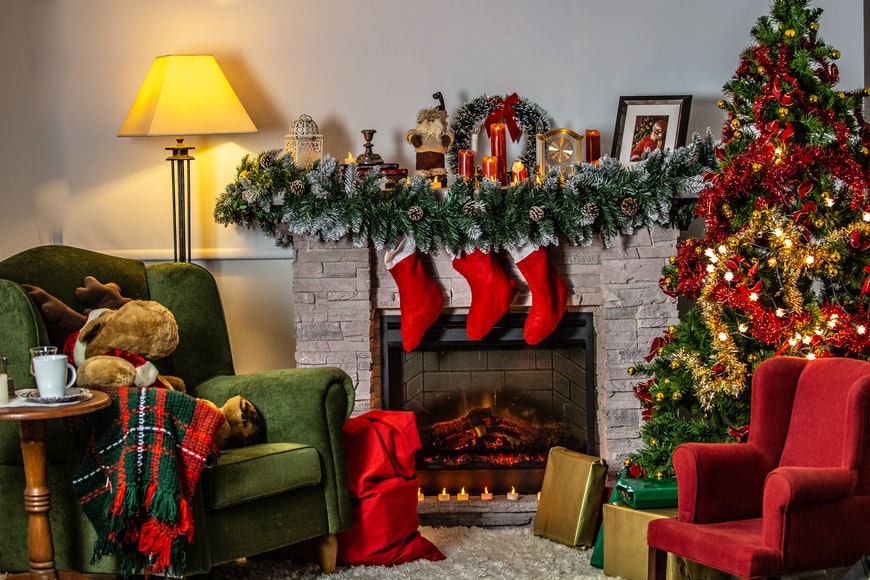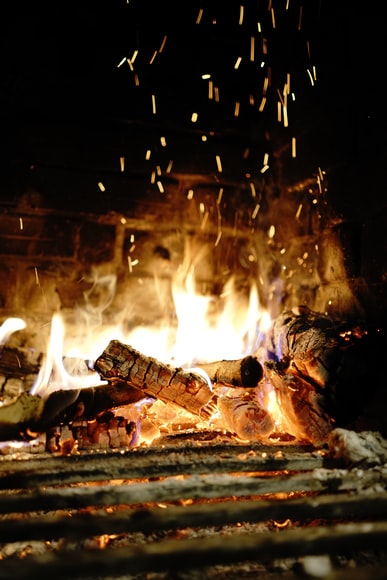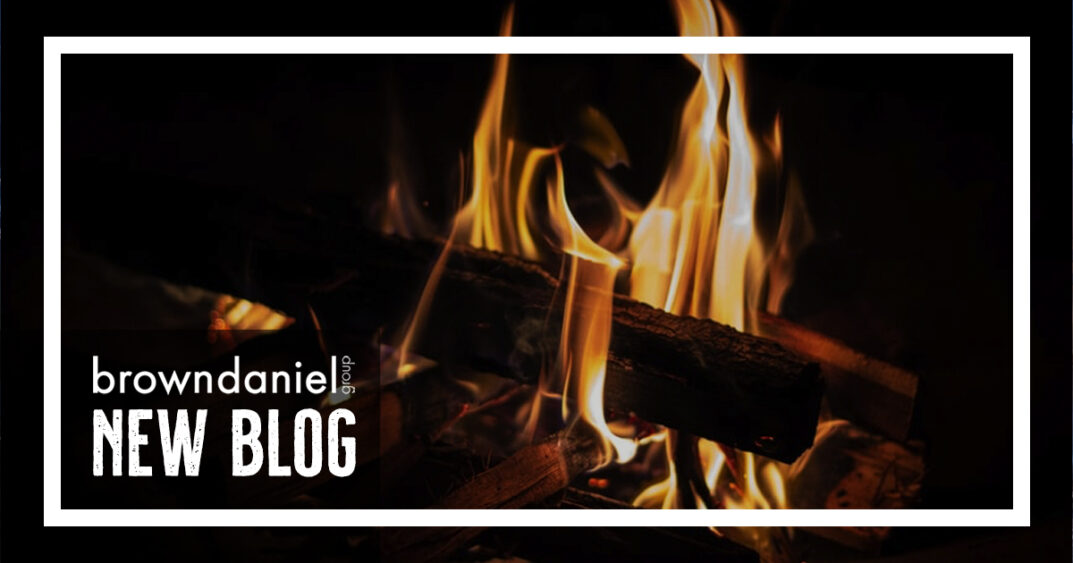
A crackling fire burning in the fireplace is the quintessential winter scene for many, and while gas logs are becoming more and more popular, many people still enjoy the authentic feel of an old fashioned wood-burning fireplace. Along with the cozy warmth of a burning fire, fireplaces provide low cost heating that helps offset energy bills during the winter months. But before you light that first fire, there are some upkeep tasks that you will need to take care of first to make sure your fire burns bright and safe. Approximately 40% of heating related house fires involve the fireplace and chimney, so this is an essential part of keeping your home and family safe this winter.
Schedule an Inspection
The most important step for you to take in getting your fireplace ready for the winter is to schedule an annual inspection with a chimney and fireplace professional. In colder climates, experts actually recommend this inspection be done after every 80 or so fires. Here in Atlanta, we don’t see quite enough cold weather for most people to go through this many fires during the winter season, but if you are a heavy fireplace user, you should be aware of the 80 fire rule. If you have a traditional wood-burning fireplace, a thorough cleaning by a chimney expert will remove any buildup of creosote, which is the oily and highly flammable byproduct of burning wood. Creosote builds up in the flue that lines the chimney, and when the internal flue temperature gets hot enough or sparks reach the creosote, it can ignite a chimney fire.
Check for Damage Outside
At least once each year you need to do a visual check of the outside of your chimney, to look for cracks in the brick or stone that makes up your chimney. If you haven’t had a reason to hop up on your roof in a while, perhaps getting into the habit of doing this while stringing your Christmas lights is a good idea. Of course, if you are not comfortable climbing onto your roof, you can request this as part of your usual chimney inspection, but most serious cracks should be visible from the ground. A professional mason will need to be called in to handle any needed repairs. Firebrick, which is used in chimneys, cannot be fixed with regular mortar, which is not strong enough to stand up to the heat produced by your fireplace.
Clear the Clutter

It happens in many homes – you don’t use your fireplace for several months, and the clutter of daily life begins to encroach upon your mantle and hearth. Before you light your first fire, make sure you take some time to clear the area around your fireplace. Some of the items that are located close to the fireplace could become a fire hazard once you light the first fire, but aside from any dangerous situations, having too many items located close to your fireplace detracts from the natural beauty of a warm fire. While decorative items are the most likely culprit found too near the fireplace, you should also make sure that all furniture and rugs are kept a safe distance away.
Check on Your Damper
The chimney damper is a valve or plate that regulates the airflow inside the chimney. The damper usually opens or closes using a push rod, rotary control, or pull chain. It is very important for your chimney’s damper to be working properly, so make sure there is nothing preventing it from thoroughly opening and closing. After you try to open the damper, you should be able to tell if it is working correctly because you’ll likely feel a breeze, or you will be able to see up the flue when you peak your head in. Make sure that your chimney cap is well-attached and in good condition. These caps are important for keeping pests out of your chimney, such as squirrels and birds, and making sure rain doesn’t pour into your chimney during a storm.
Trim the Trees
If there are any tree limbs hanging over your chimney, these should be pruned back, especially if they are actually encroaching on your chimney. If this is an ongoing problem, in that you find yourself trimming the limbs of the same trees year after year, you might even consider removing any trees with limbs that dangle too close. Not only are overhanging limbs a fire hazard, but they also restrict the proper draft and airflow around your chimney, which can result in damage over time. Tree limbs can cause damage to your chimney’s external structure, while at the same time hiding that damage from the naked eye so that you do not notice it when doing your visual inspection.
Ongoing Upkeep

For a wood-burning fireplace, make sure that you remove all ash on a frequent basis, at least once each week during regular use, or when the ash reaches one inch in depth. Remember that coals can remain hot for up to three days, and you want to make sure that everything is completely cool before you dispose of the ash. Sweep up or vacuum out cooled ashes, and remove them to an outdoor area. Wood ash is an excellent fertilizer, so you can dispose of it onto any garden beds or compost piles. And here’s a hint to reduce flyaways when you are removing the ashes. Sprinkle them first with coffee grounds! You’ll have less ash escaping out into the room if you do this first. You can also invest in a special ash vacuum rather than using your usual household vacuum.
While you are putting your fireplace into regular use, you should make sure that your home’s fire and carbon monoxide alarms are in good working order. Even if your alarms are hardwired into your home, check the battery backups to make sure they are full of juice before you light the first fire of the season. Make a mental note to check all of these alarms on a regular basis throughout the season in which you will be using your fireplace.
Keep These Things Out of Your Fireplace
Most of the things you shouldn’t burn in your fireplace are rather obvious, but there are a few products you might not realize should be kept out of your crackling home fire. For example, you should never use coated or pressure treated wood in an indoor fireplace. This could cause a release of toxic chemicals into your home, sickening the air that you and your family are breathing. Treated wood is meant to withstand insects and rot outdoors, and can include many harmful chemicals such as arsenic. Plywood has the same problem due to the adhesives used when it is made.
Cardboard and magazines are occasionally used to start campfires and grills, but you should avoid using it as a firestarter indoors. Most commercial cardboard is treated with chemicals, so you are better off using firestarters that are approved for indoor use, which are available at most camping supply stores, and even many grocery and department stores during the winter months. The same is true for magazines. The ink used to create those colorful layouts and glossy pages is filled with toxic chemicals. If your fire needs a quick boost, you can use a few sheets of rolled up, black and white only, newspaper placed beneath your logs.

Make sure your firewood is completely dry before using it in your home’s fireplace, as you also want to avoid using wet wood inside. Wet wood is not only harder to light, but it also leads to a faster and thicker build up of creosote, the oily residue that must be cleaned from your chimney every year before fireplace season. If you use wet wood in your fireplace, this creosote buildup can become dangerous before the end of winter, and before you would normally have your chimney cleaned and inspected again. A chimney dirty with creosote is one of the leading causes of chimney fires, so using only dry firewood is an absolute necessity. Wood from evergreen trees can cause the same problem, but many people like to use a little bit of it to get a fire going because it burns quickly and produces a hot flame. It’s best to skip the cedar branches though in favor of a cleaner chimney.
If you live on a rural or wooded lot, you might have considered chopping a little bit of your own firewood rather than purchasing it. You should only do this if you are very familiar with the trees on your property and what variety you might be putting in your fireplace. Many trees are rarely used for firewood because they are common allergens, and using their wood might unknowingly trigger an allergic response from someone in your home. This is especially true with smaller trees and vines, so even using a small amount for fire starter isn’t a good idea if you don’t know what you are working with.

